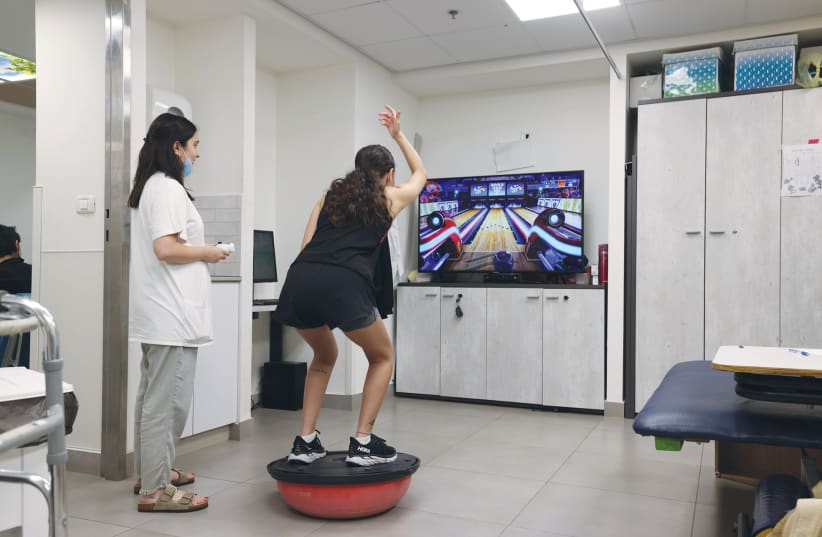A few comments embedded in the article
Robots in rehabilitation: Enhancing physiotherapy with socially assistive robots
Socially assistive robots (SARs) are transforming physiotherapy for post-stroke patients, significantly improving rehabilitation outcomes by providing consistent, encouraging guidance and interaction.

Glad to see this patient round side down on the Bosu. It's more difficult to stay upright but I thought that standing on the round side increased the chances of rolling my ankle.
Most people know nothing about what a physiotherapist does until they, a friend, or a relative needs one. These well-trained and licensed healthcare professionals, working according to evidence-based protocols, can treat a large number of injuries and conditions – from arthritis, stroke, and back pain to bone fractures, carpal-tunnel syndrome, and sciatica.
Although the four Israeli public health funds provide physiotherapists for many patients even at no cost but with a limited number of sessions, for some conditions and in many countries, physiotherapists are hard to get, and queues are long.
For physiotherapy to succeed, the patient must cooperate and perform exercises as instructed on a regular basis. Patient cooperation and active involvement in the process are vital for successful rehabilitation, and a lack of motivation is often one of the main reasons for poor outcomes.
--------------------------------------------------------------------------------------------------
User engagement/motivation is simple.
You don't understand ONE GODDAMN THING ABOUT SURVIVOR MOTIVATION, DO YOU? You create EXACT 100% recovery protocols and your survivor will be motivated to do the millions of reps needed because they are looking forward to 100% recovery. GET THERE!
The problem is stroke researchers are not motivated to solve stroke. What the fuck is your solution to that failure? We still don't know how to motivate stroke medical 'professionals' to solve stroke to 100% recovery!
---------------------------------------------------------------------------------
Can robots supplement the work of human physiotherapists? Using a socially assistive robot (SAR) in post-stroke rehabilitation improves outcomes, according to researchers at Beersheba’s Ben-Gurion University of the Negev (BGU). They conducted the first long-term study of using robots for physical therapy, opening a totally new method for rehabilitation exercises.
Given the fact that over 10,000 soldiers were wounded in the Gaza war and on the northern front since October 7, the need for physical rehabilitation is immense.
Socially assistive robots use speech, gestures, and facial expressions to guide and coach patients. There is no need to make an appointment; they will be brought to your home and stay with you. In addition, they are programmed to provide endless encouragement without judging the patient!
Prof. Shelly Levy-Tzedek, Dr. Ronit Feingold-Polak, and Oren Barzel found that SARs worked better than computers or no technological intervention when combined with the usual care.


Levy-Tzedek is a member of BGU’s physical therapy department in the Recanati School for Community Health Professions and a member of the Institute for Advanced Studies at Germany’s University of Freiburg. Feingold-Polak is also a member of that department, as well as at Jerusalem’s Herzog Medical Center, while Barzel works at Sheba Medical Center at Tel Hashomer and the Adi-Negev Rehabilitation Center, the first and only rehabilitation hospital in southern Israel.
THEIR FINDINGS have just been published in IEEE Transactions on Neural Systems and Rehabilitation Engineering – one of the leading rehab journals – under the title “Socially assistive robot for stroke rehabilitation: a long-term in-the-wild pilot randomized controlled trial.”
“The use of robots could greatly improve the results of rehabilitation by encouraging people to continue their treatment in what they feel is a non-judgmental setting. Our study found that people enjoyed their interactions with the SAR, as they helped improve their recovery over working with a computer or without any technological assistance,” Levy-Tzedek said in a press release issued by BGU.
A total of 26 patients receiving the usual care were randomly divided into three groups: also training with a SAR, also training with a computer, and getting no additional intervention. The intervention sessions took place three times weekly for 15 sessions per patient over two years, with 306 sessions held.
In five of the games, the patient had to arrange a set of real objects used daily such as cups or jars according to an image shown on the robot’s or the computer’s screen. The other two games were an interactive card game. In the first five sets there were several difficulty levels that increased by changing the height of the platform, as well as the weight and the number of the objects.
The Kaylie Rehabilitation Medical Center at ADI Negev-Nahalat Eran has improved the care of Negev residents in need of inpatient rehabilitation following a serious illness, accident, or terror attack by implementing revolutionary rehabilitation techniques, using international experts in various fields to train its medical residents and offering services unavailable anywhere else in Israel.
By providing inpatient and long-term outpatient services and treatments, the facility is keeping families together throughout the rehabilitation process while also immersing them in the village’s inclusive environment offering physiotherapy, hydrotherapy, occupational therapy, communication therapy, and a sports center.
Those in the SAR group significantly improved their smoothness of movement, the action research arm test, and the Fugl-Meyer upper-extremity assessment. No significant improvement was found in the computer or the control groups. Each of the SAR participants gained improvement that reached or exceeded the gold standard for activity performance of the upper limbs after a stroke.
In a press release, Feingold Polak concluded that, “We showed both the feasibility and the clinical benefit of using a SAR for long-term interaction with post-stroke individuals as part of their rehabilitation program.”
No comments:
Post a Comment